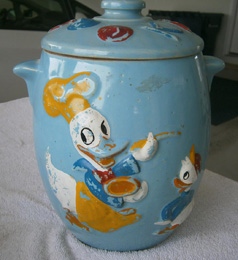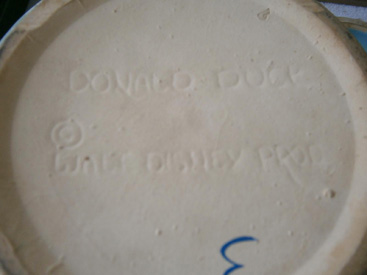 |
|
|||
 |
 |
|||
Copyright © Harry Rinker, LLC 2014
Questions
and Answers
ANSWER: I was not able to identify the manufacturer of your cookie jar. I did find other examples of the same cookie jar pattern with a tan or black background. It is American made and probably dates from the late 1940s. The Leeds China Company of Chicago made three Disney turnaround (a separate image on each side) cookie jars – Mickey/Minnie Mouse, Donald Duck/Joe Carioca, and Dumbo with trunk up/Dumbo with trunk down. These jars measured between 13 and 14 inches in height. They are much easier to find on the secondary market than your Donald Duck and nephew cookie jar.
Leeds China cookie jars as well as your cookie jar version all had paint applied above the glaze. As a result, even gentle washing resulted in paint loss. Rough handling guaranteed the loss. An example identical to your jar sold on eBay on December 19, 2013, for $64.99 with free shipping. Your example has better paint. As such, your Donald Duck and nephew cookie jar has a value between $85.00 and $95.00. QUESTION: I have a Made-Rite washboard with a metal insert. The stenciling on the wood frame still is readable. I would like to learn more about this washboard. – B, St. Ignace, MI ANSWER: Your washboard was made by the Columbus Washboard Company, Columbus, Ohio. While it most likely dates from the 1930s, it could date as late as the 1970s. Frederic Martin, Sr., started manufacturing homemade washboards in his backyard in 1895. He continued his one-man, homemade approach for 30 years. Frederic Martin, Jr., purchased the company from his father in 1925. The assets included goodwill, a patent and trademark for the “Bear Easy” washboard, metal crimping machine, and saws. Frederic Jr.’s wife Margaret joined him in the business. Until 1930, the Bear Easy was the only washboard sold by the Columbus Washboard Company. The company introduced 22 other trademarked brands in the 1930s, including Maid-Rite Silver and Maid-Rite Brass. The Columbus Washboard Company made 1,331 washboards in 1926. By 1941, annual production increased to 1,287,757 boards. Columbus Washboard Company introduced the glass washboard during World War II. Washboard sales declined following World War II. By the end of the 1960s, Columbus Washboard Company was the only American manufacturer of washboards still in business. Competitors such as Cleveland Washboard Company, National Washboard Company, and Superior Washboard Company had closed their doors. Pat Taylor, Frederic Jr.’s and Martha’s niece, and her husband C. G. Mike Taylor assumed control of the business in 1987. They decided to stake the future of the company to supplying washboards for the “Country Style.” In 1999, Mike and Pat Taylor sold the company to a group of investors who moved the manufacturing plant to the former Godman Shoe factory in Logan, Ohio in 2001. The company still makes washboards. [See: www.columbuswashboard.com/our_history for a more detailed history of the company.] The asking price for older family-size Maid-Rite washboards ranges from $15.00 to $25.00, depending on condition. Modern examples sell in the $30.00 plus range. Maid-Rite is a popular brand for bluegrass, hillbilly, and country music artists. An internet advertisement notes the board is excellent for “jugband, zydeco, and Cajun…holds up to abuse.” QUESTION: I own a copy of Richard H. Pough’s “Audubon Bird Guide: Eastern Land Birds” that was published by Doubleday and Company in 1946. Does it have any value? – S, Reading, PA ANSWER: According to www.amazon.com, leather bound copies range from $0.90 used to $15.95 in collectible (near mint) condition. Paperback versions are listed around $10.00. Hence, no is the correct answer. Having stated this and realizing antiques and collectibles value is subjective, you might see additional value in your copy of Pough’s book if you know something about the author. Richard H. Pough, a founder of the Nature Conversancy, devoted his life to conservation efforts. During his distinguished career, he worked for the American Museum of Natural History and the National Audubon Society. His accomplishments include helping pass the law that banned the sale of wild-bird feathers, being one of the earliest individuals to warn against the destructive powers of DDT, and establishing numerous nature preserves along the eastern seaboard and in Arizona. Pough gained initial fame by calling attention to the massacre of hawks at what is now the Hawk Mountain Sanctuary located near Reading, Pennsylvania. In 1936, when his wife returned home with a hat featuring eagle feathers, he began his crusade against the use of all types of bird feathers, whether the species were endangered or not. Pough bird guides included information about bird behavior, an approach that differentiates his guides from the popular Peterson identification guides. In addition to his guide on Eastern land birds, he also wrote Audubon guides for the Midwest, Western birds, and water birds. While at the American Museum of Natural History, Pough supervised the installation of the Hall of North American Forests, an exhibit that is still popular today. He left the museum to take a more active role in environmental conservation projects. [See https://www.google.com/?gws_rd=ssl#q=richard+h.+pough+birds for more detailed information about Pough’s accomplishments. QUESTION: I own a Hurd Supercaster fishing rod/reel combination and the case that accompanied it. What is its history and value? – J, Janesville, WI ANSWER: The Hurd Lock & Manufacturing Company’s Sporting Goods Division produced the Hurd Caster and Supercaster, a rod and reel combination in the late 1940s. The Caster sold for $27.50 and Supercaster for $45.00. A magazine advertisement describes the Caster as: “The new spool drag of the in-built reel is made to the highest precision standards. It may be adjusted to fine degree as to virtually eliminate backlash….” The Supercaster “is designed for sportsmen who desire the finest in outdoor equipment…” Hurd used wooden handles from1945-1946 and plastic handles from 1947-1951. William M. Stuart of Newark, New Jersey, patented the first rod/reel combination in 1865. As the 19th century ended, over two dozen rod/reel patents had been filed. Hurd’s Caster and Supercaster were late arrivals and marketed to compete with the Gentleman Streamliner combination made by a Chicago firm. The late 1940s witnessed the arrival of spin casting. Spin casting rapidly replaced bail casting outfits. Hurd and other rod/reel manufacturers fell by the wayside. Companies such as Good-All Electric in Nebraska and Great Lakes Whirlaway did make combination rod/spinning reels. [For more information, see: http://www.oldreels.com/hurd.htm and http://antiquefishingreels.info/FAQcombos.htm] Although it cost less, the Hurd Caster is more desirable among collectors than the Supercaster. A Supercaster with its case, both in very fine condition, retails on the secondary market in the $100.00 to $150.00 range.Harry L. Rinker welcomes questions from readers about
collectibles, those mass-produced items from the twentieth and twenty-first centuries.
Selected letters will be answered in this column.
Harry cannot provide personal answers.
Photos and other material submitted cannot be
returned.
Send your questions to: Rinker on Collectibles, 5955 Mill
Point Court SE, Kentwood, MI 49512.
You also can e-mail your questions to
harrylrinker@aol.com.
Only e-mails containing a full name and mailing address
will be considered.
You can listen
and participate in
WHATCHA GOT?, Harry’s
antiques and collectibles radio call-in show, on Sunday mornings between 8:00 AM
and 10:00 AM Eastern Time.
If you
cannot find it on a station in your area,
WHATCHA GOT?
streams live on the Internet at www.gcnlive.com.
SELL, KEEP OR TOSS?: HOW TO DOWNSIZE A HOME,
SETTLE AN ESTATE, AND APPRAISE PERSONAL PROPERTY
(House of Collectibles, an imprint of Random House Information Group, $17.99),
Harry’s latest book, is available at your favorite bookstore and via
www.harryrinker.com.
|
||||
 QUESTION: When cleaning out an elderly aunt’s home, I found a Donald Duck and nephew cookie jar. Donald Duck is wearing a chef’s hat and apron and tasting the contents of a bowl of soup. The cookie jar has a powder-blue ground. The lid reads “COOKIES” in relief. Some of the over the glaze painting has been lost. The base is impressed “DONALD DUCK / © / WALT DISNEY PROD.” The jar is 9 3/4 inches tall. What is my Donald Duck and nephew cookie jar worth? – CW, Janesville, WI, Email Question
QUESTION: When cleaning out an elderly aunt’s home, I found a Donald Duck and nephew cookie jar. Donald Duck is wearing a chef’s hat and apron and tasting the contents of a bowl of soup. The cookie jar has a powder-blue ground. The lid reads “COOKIES” in relief. Some of the over the glaze painting has been lost. The base is impressed “DONALD DUCK / © / WALT DISNEY PROD.” The jar is 9 3/4 inches tall. What is my Donald Duck and nephew cookie jar worth? – CW, Janesville, WI, Email Question The
The